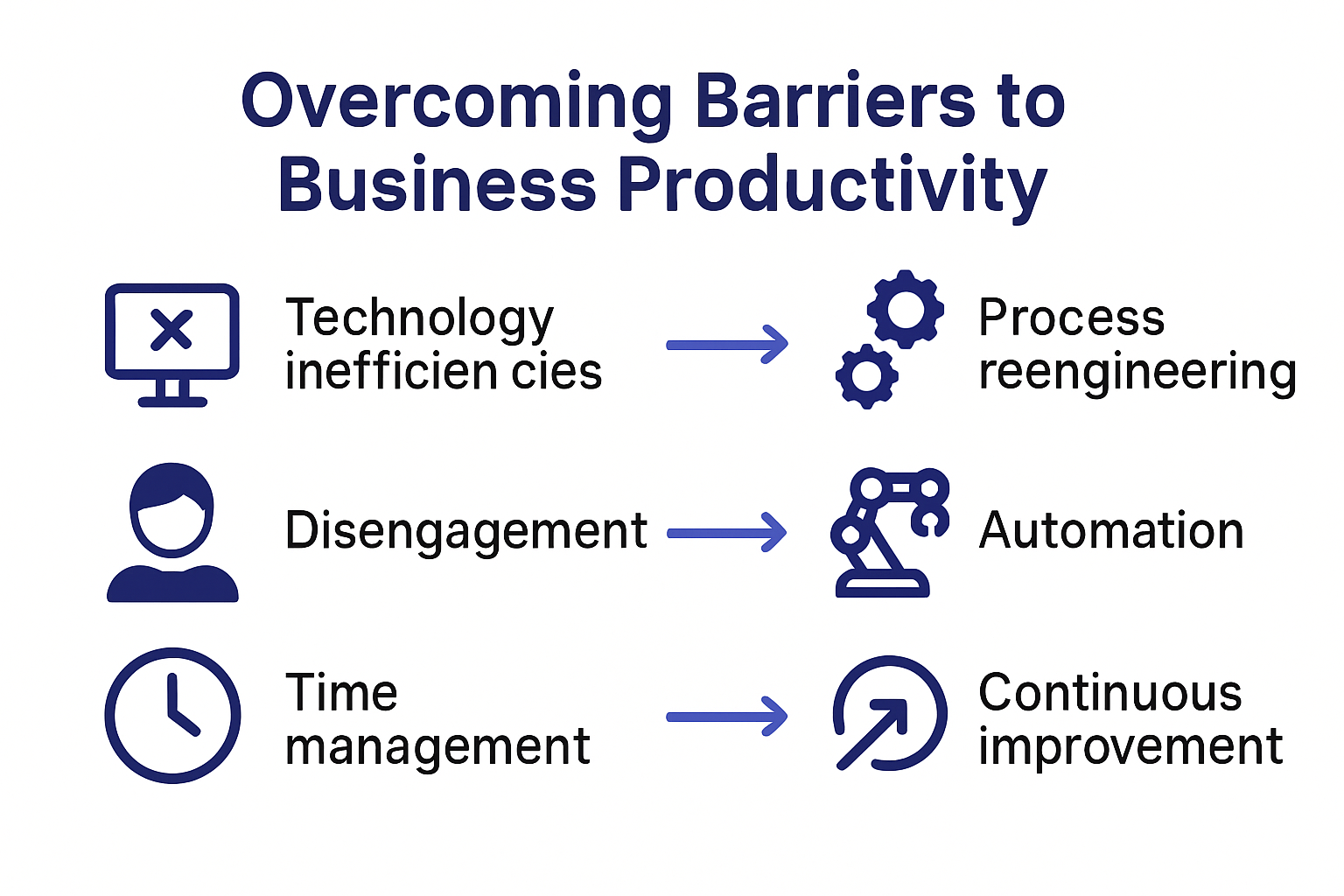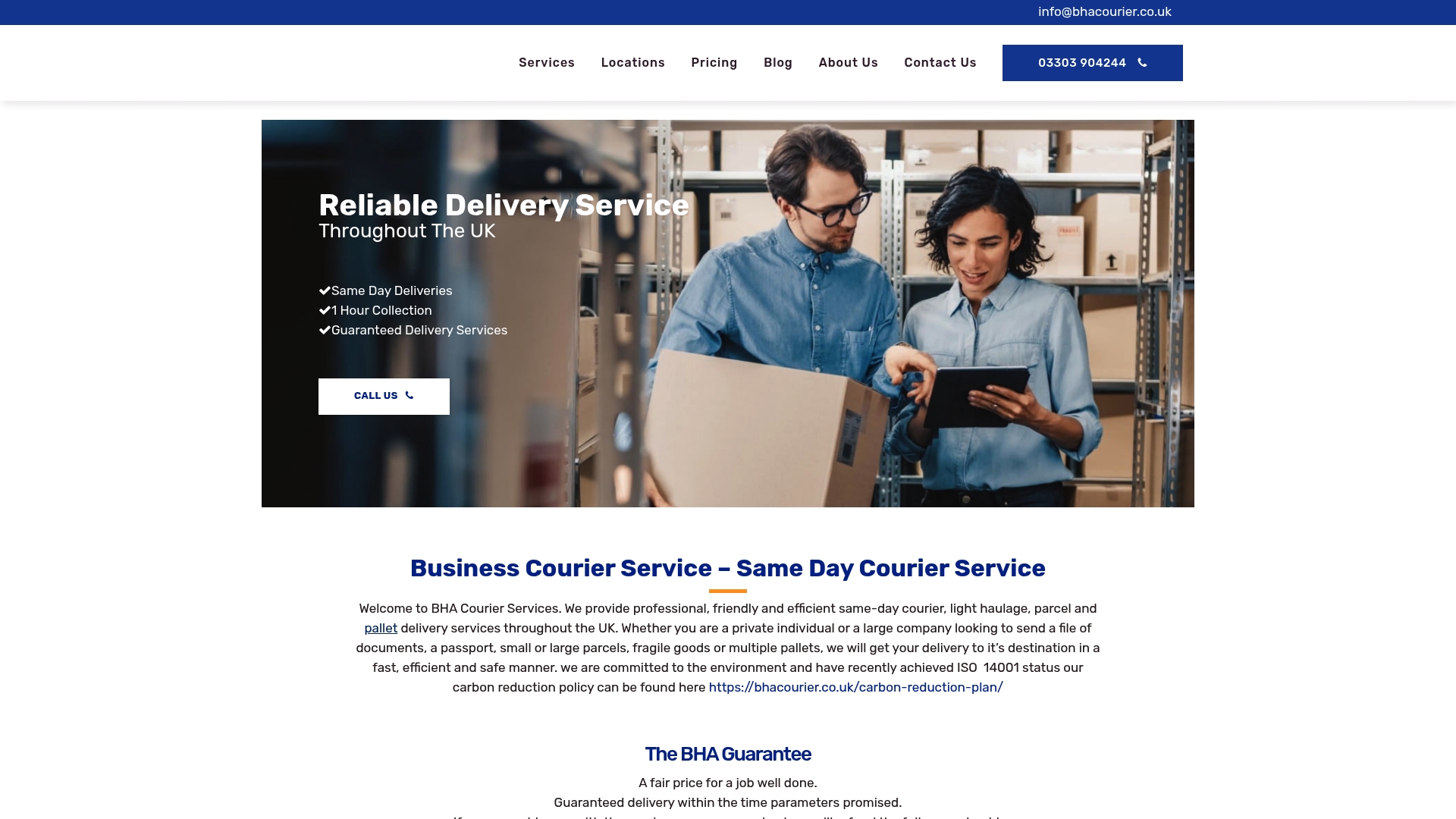
01 Aug Top Strategies for Improving Business Productivity in 2025
Business productivity is shaping company success now more than ever. Surprising as it sounds, inefficient communication tools and fragmented technology can cut workplace productivity by up to 25 percent according to recent research. Yet upgrading technology is not the whole answer. The real breakthrough comes when people and culture move in sync with smarter workflows and clever tech.
Table of Contents
- Identifying Key Barriers to Productivity
- Practical Steps for Streamlining Business Processes
- Leveraging Technology and Tools for Better Results
- Building a Productive Culture Within Your Team
Quick Summary
| Takeaway | Explanation |
|---|---|
| Invest in integrated technology solutions. | Streamlined technology enhances communication and reduces inefficiencies across departments, improving overall productivity. |
| Cultivate a positive workplace culture. | Employee engagement and recognition are crucial for motivation, leading to higher productivity levels and job satisfaction. |
| Implement clear accountability structures. | Transparent expectations and regular feedback help motivate employees and align their goals with organisational objectives. |
| Foster continuous learning opportunities. | Providing training and development resources empowers employees to enhance their skills and adapt to changes effectively. |
| Utilise data-driven performance metrics. | Regular assessment of processes through KPIs allows businesses to identify areas for improvement and make informed decisions. |
Identifying Key Barriers to Productivity
Improving business productivity requires a strategic approach to understanding and eliminating the obstacles that hinder organisational performance. Businesses face numerous challenges that can significantly impact their operational efficiency and overall productivity.
Technology and Communication Inefficiencies
Modern businesses frequently struggle with technology-related productivity barriers. Gartner Research reveals that inefficient communication tools and fragmented technology ecosystems can reduce workplace productivity by up to 25%. Many organisations experience significant time wastage due to:
- Incompatible Software Systems: Multiple platforms that do not integrate seamlessly
- Communication Bottlenecks: Delayed information sharing and complex communication channels
- Outdated Technology Infrastructure: Slow systems that impede rapid task completion
Businesses must invest in streamlined technological solutions that enable smooth workflows and reduce unnecessary friction between team members and departments.
Workplace Culture and Employee Engagement
McKinsey & Company highlights that disengaged employees represent a critical barrier to improving business productivity. When workers feel disconnected or undervalued, their motivation and performance inevitably suffer. Key cultural challenges include:
- Poor Management Practices: Lack of clear direction and supportive leadership
- Limited Professional Development: Insufficient opportunities for skill enhancement
- Inadequate Recognition Systems: Minimal acknowledgment of individual and team achievements
Creating a positive workplace environment that prioritises employee well-being and professional growth is essential for maintaining high productivity levels.
Time Management and Workflow Disruptions
Unproductive time management practices can dramatically reduce an organisation’s overall efficiency. Complex administrative processes, unnecessary meetings, and inefficient task allocation consume valuable working hours. Businesses must develop robust strategies to:
- Implement clear prioritisation frameworks
- Reduce unnecessary bureaucratic procedures
- Encourage focused work periods with minimal interruptions
- Utilise productivity tracking tools that provide actionable insights
By systematically addressing these key barriers, organisations can create a more dynamic, efficient, and responsive workplace environment that maximises human potential and technological capabilities. The journey towards improving business productivity requires continuous assessment, adaptability, and a commitment to creating systems that empower employees and streamline operational processes.

Practical Steps for Streamlining Business Processes
Streamlining business processes is a critical strategy for improving organisational efficiency and productivity. By systematically evaluating and optimising workflows, businesses can reduce operational costs, enhance performance, and create more agile working environments.
To help visualise and compare the primary strategies for streamlining business processes mentioned, the table below organises methods, key actions, and potential benefits for each approach described in this section.
| Strategy | Key Actions | Potential Benefits |
|---|---|---|
| Business Process Re-engineering (BPR) | Process mapping, identify redundancies, value stream analysis | 30-50% efficiency improvement |
| Technology & Automation Integration | Automate workflows, use machine learning, use cloud platforms | Reduce operational costs up to 60% |
| Continuous Improvement & Feedback | Regular reviews, employee feedback, data-driven KPIs | Ongoing adaptability; higher performance |
Business Process Re-engineering and Analysis
Business Process Re-engineering (BPR) represents a fundamental approach to transforming organisational workflows. Deloitte Research indicates that organisations implementing comprehensive process re-engineering can achieve efficiency improvements of 30-50%. Key strategies include:
- Process Mapping: Detailed documentation of existing workflows
- Identifying Redundancies: Eliminating unnecessary steps and bottlenecks
- Value Stream Analysis: Focusing on activities that directly contribute to customer value
Successful re-engineering requires a holistic view of organisational processes, considering both technological and human factors that impact performance.
Technology and Automation Integration
Modern businesses can significantly enhance productivity through strategic technology adoption. McKinsey Global Institute reports that intelligent automation can reduce operational costs by up to 60% while improving accuracy and speed. Practical implementation involves:
- Workflow Automation Tools: Implementing software that reduces manual administrative tasks
- Machine Learning Algorithms: Developing intelligent systems that adapt and improve processes
- Cloud-Based Collaboration Platforms: Enabling seamless communication and document sharing
Technology integration should focus on creating interconnected systems that support rather than replace human expertise.
Continuous Improvement and Feedback Mechanisms
Establishing a culture of continuous improvement is essential for maintaining streamlined business processes. Harvard Business Review emphasises the importance of creating feedback loops that allow organisations to adapt and evolve. Effective strategies include:
- Regular Performance Reviews: Systematic assessment of process effectiveness
- Employee Feedback Channels: Creating platforms for team members to suggest improvements
- Data-Driven Performance Metrics: Implementing key performance indicators (KPIs) that track process efficiency
By embracing a dynamic approach to process management, businesses can create responsive and adaptive organisational structures that consistently deliver high performance. The key lies in balancing technological innovation with human creativity and maintaining a flexible mindset towards operational excellence.
Leveraging Technology and Tools for Better Results
Technology continues to revolutionise business productivity, offering sophisticated tools that transform traditional work methodologies and enhance organisational performance. By strategically integrating advanced technological solutions, businesses can unlock unprecedented levels of efficiency and competitive advantage.
Artificial Intelligence and Cognitive Computing
Research from 2025 proposes a groundbreaking approach to understanding technological productivity by recognising ‘digital labor’ as a distinct factor of production. This perspective shifts how organisations conceptualise technological contributions to workplace efficiency. IBM Research indicates that AI-powered tools can improve business productivity by approximately 40% through intelligent automation and predictive analytics.
Key AI applications include:
- Intelligent Process Automation: Reducing repetitive administrative tasks
- Predictive Decision Support: Generating data-driven insights for strategic planning
- Advanced Performance Monitoring: Real-time evaluation of organisational workflows
Businesses must view AI not as a replacement for human workers, but as a collaborative tool that amplifies human capabilities and strategic thinking.
Robotics and Workforce Augmentation
Research from 2020 highlights the transformative potential of robotics in complementing human workforce capabilities. Gartner Research suggests that organisations implementing robotic process automation can achieve productivity gains of 25-40% across multiple operational domains.
Strategic robotics integration involves:
- Collaborative Robotic Systems: Designing workflows where humans and robots work synergistically
- Task-Specific Automation: Identifying repetitive processes suitable for robotic intervention
- Skill Development Programmes: Training employees to work alongside technological systems
Agile Project Management Technologies
A 2018 academic paper explores the integration of artificial intelligence into agile project management, demonstrating how technological tools can dramatically enhance project delivery and team productivity. Project Management Institute reports that advanced project management technologies can reduce project completion times by up to 30%.
Effective technological project management strategies include:
- Real-Time Collaboration Platforms: Enabling seamless communication across distributed teams
- Intelligent Resource Allocation: Using AI to optimise team workloads and project assignments
- Automated Progress Tracking: Implementing systems that provide instant performance insights
The future of business productivity lies in creating adaptive, technology-enhanced ecosystems that seamlessly blend human creativity with technological efficiency. Success requires a holistic approach that views technology as an enabler of human potential rather than a replacement for human expertise.
To better understand the impact and use-cases of key emerging technologies in productivity enhancement, the following table organises technologies, selected applications, and the scale of productivity improvement referenced in this section.
| Technology | Key Applications | Productivity Improvement |
|---|---|---|
| Artificial Intelligence (AI) | Automation, predictive analytics, monitoring | +40% (IBM Research) |
| Robotics & Robotic Process Automation | Collaborative systems, repetitive task automation | +25–40% (Gartner Research) |
| Agile Project Management Tools | Real-time collaboration, resource allocation | Up to 30% faster project delivery |
Building a Productive Culture Within Your Team
Creating a high-performance team culture requires strategic planning, intentional leadership, and a comprehensive approach to nurturing employee potential. By focusing on specific cultural elements, organisations can transform their workplace environment into a dynamic ecosystem of productivity and innovation.
Establishing Clear Accountability and Expectations
Gallup Research demonstrates that organisations with robust accountability cultures experience 22% higher productivity rates. Harvard Business Review emphasises the importance of setting transparent performance expectations and creating measurable goals that align with organisational objectives.
Key strategies for building accountability include:
- Clear Performance Metrics: Developing specific, measurable objectives for each team member
- Regular Performance Feedback: Implementing consistent review mechanisms
- Transparent Goal Setting: Ensuring individual targets connect with broader organisational aims
Successful accountability requires a balanced approach that motivates employees without creating punitive environments.
Fostering Psychological Safety and Collaboration
Google’s Project Aristotle revealed that psychological safety is the most critical factor in high-performing teams. MIT Sloan Management Review indicates that teams with high psychological safety demonstrate improved innovation, learning, and productivity.
Effective strategies for creating psychological safety include:
- Open Communication Channels: Encouraging honest dialogue and feedback
- Inclusive Decision Making: Involving team members in strategic discussions
- Normalising Failure as Learning: Treating mistakes as opportunities for growth
Leaders must actively create environments where employees feel secure sharing ideas and taking calculated risks.
Professional Development and Continuous Learning
LinkedIn Learning reports that organisations with strong learning cultures are 46% more likely to be industry leaders. Deloitte Research highlights the importance of continuous skill development in maintaining team productivity and engagement.
Comprehensive learning strategies encompass:
- Structured Training Programmes: Providing targeted skill enhancement opportunities
- Mentorship Frameworks: Creating knowledge transfer mechanisms
- Personal Development Resources: Supporting individual learning journeys
By investing in employee growth, organisations create a culture of continuous improvement and adaptability.
Building a productive team culture is an ongoing process that requires commitment, strategic thinking, and genuine investment in human potential. Success emerges from creating holistic environments that balance individual needs with collective objectives, ultimately transforming workplace dynamics into powerful engines of innovation and performance.

Frequently Asked Questions
What are the key barriers to improving business productivity?
The main barriers include technology and communication inefficiencies, workplace culture issues, and time management disruptions. Ineffectively integrated software, poor employee engagement, and a lack of prioritisation can all hinder productivity.
How can technology enhance business productivity?
Implementing integrated technology solutions, such as automation and AI, can significantly improve productivity. These tools streamline workflows, reduce manual tasks, and enable better communication across teams.
What role does workplace culture play in productivity?
A positive workplace culture fosters employee engagement, motivation, and collaboration. When employees feel valued and supported, they are more likely to be productive and committed to their work.
What strategies can businesses use to implement continuous improvement?
Businesses can use strategies such as regular performance reviews, employee feedback mechanisms, and data-driven KPIs to facilitate continuous improvement. This approach allows organisations to adapt and enhance their processes over time.
Turn Time Savings into Real Productivity Gains with BHA Courier
When workplace productivity is threatened by inefficient processes or missed deadlines, even the best strategies can fall short. The article highlights how time management and workflow disruptions are serious barriers to business efficiency. If your operations are affected by delayed deliveries or tangled logistics, your team’s hard work may go unnoticed, goals slip through the cracks, and growth stalls. Imagine the difference if your business communication, customer promises, and urgent documents always arrived seamlessly, every time.

Now is the time to transform your business reliability into a competitive advantage. With BHA Courier’s same-day and next-day delivery solutions, you remove uncertainty and gain total control over your essential shipments. Our trusted network provides secure, rapid service for everything from urgent parcels to confidential documents, so your team never has to waste a minute chasing lost deliveries or explaining missed deadlines. Discover how our professional UK courier services can help you drive productivity improvement, meet tighter timeframes, and keep every commitment. Visit https://bhacourier.co.uk to get started right now.

Sorry, the comment form is closed at this time.